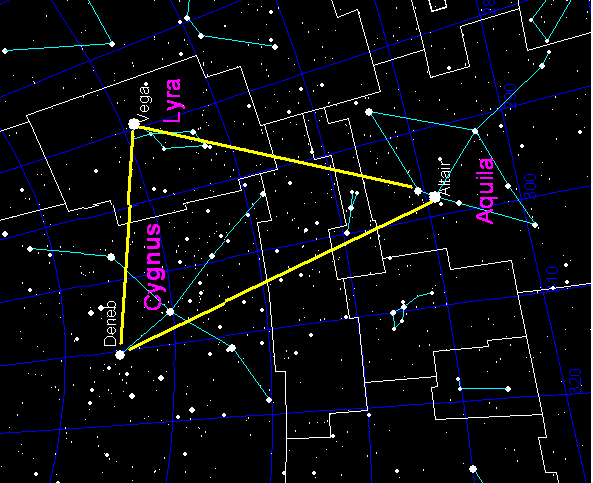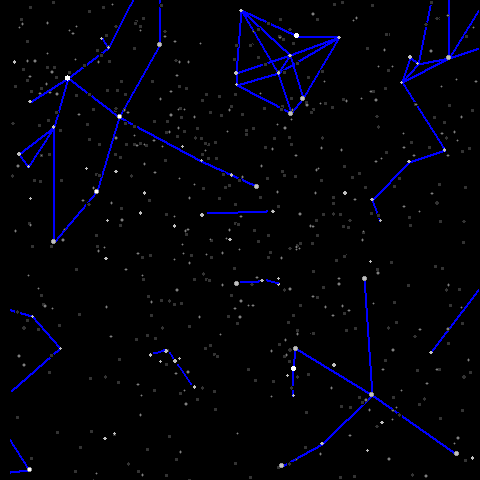Summer Triangle dominates the night sky in Northern Hemisphere

During the summer sky watchers in the Northern Hemisphere can observe the famous "Summer Triangle" which form stars Vega, Altair an Deneb. Actually, the triangle can be seen from the mid-northern latitudes throughout the year, but it is especially visible during the summer season.
Interestingly Vega, Altair and Deneb are not only the brightest stars in the summer night sky, but they are also the brightest in their own constellations. Out of this trio the brightest is the white-blue Vega in the constellation Lyra, then the yellow-white Altair in Aquila, and finally the white Deneb.
As for their luminosity astronomers know Vega is without a doubt more luminous than Altair, even though it is 25 light years away from Earth, 8 more than Altair.
This means that the light we see from Vega began its journey to our planet in the year 1988, while the light from Altair "departed" in 1996.

Summer Triangle: Altaïr (Aquila), Vega (Lyra) & Deneb (Cygnus) (Credit: Michelet)
In comparison to the Sun, Altair is roughly 1.5 times bigger and 9 times brighter, while Vega is more than 3 times bigger and 58 times brighter. However, both Altair and Vega, as bright as they are, are hard to compare with Deneb.
Deneb is a huge, supergiant star that is 1500 light years away from our planet and more than 85000 times more luminous than the Sun.
The name Altair has been used since medieval times. It is an abbreviation of the Arabic phrase النسر الطائر, an-nasr aṭ-ṭā’ir (English: The flying eagle). The term Al Nesr Al Tair appeared in Al Achsasi Al Mouakket catalogue, which was translated into Latin as Vultur Volans. This name was applied by the Arabs to the asterism of α, β, and γ Aquilae and probably goes back to the ancient Babylonians and Sumerians, who called α Aquilae the eagle star. The spelling Atair has also been used.
Wega (later Vega) comes from a loose transliteration of the Arabic word wāqi‘ meaning "falling" or "landing", via the phrase an-nasr al-wāqi‘, "the falling eagle". The term "Al Nesr al Waki" appeared in the Al Achsasi Al Mouakket star catalogue and was translated into Latin as Vultur Cadens, "the falling eagle/vulture". The constellation was represented as a vulture in ancient Egypt, and as an eagle or vulture in ancient India. The Arabic name then appeared in the western world in the Alfonsine Tables, which were drawn up between 1215 and 1270 by order of Alfonso X.
Medieval astrolabes of England and Western Europe depicted Altair and Vega as birds.
The name Deneb is derived from dhaneb, the Arabic for "tail", from the phrase ذنب الدجاجة Dhanab ad-Dajājah, or "tail of the hen". Similar names were given to at least seven different stars, most notably Deneb Kaitos, the brightest star in the constellation Cetus; Deneb Algedi, the brightest star in Capricornus; and Denebola, the second brightest star in Leo. All these stars are referring to the tail of the animals that their respective constellations represent.
To observe the Summer Triangle, as the night falls, locate the brightest star in the eastern sky. When you have found Vega, to the lower left of Vega you can locate Deneb, and to the lower right is Altair.
Sources: Earthsky, Space, Wikipedia
Featured image: Summer Triangle (Credit: Tomruen)

Commenting rules and guidelines
We value the thoughts and opinions of our readers and welcome healthy discussions on our website. In order to maintain a respectful and positive community, we ask that all commenters follow these rules:
We reserve the right to remove any comments that violate these rules. By commenting on our website, you agree to abide by these guidelines. Thank you for helping to create a positive and welcoming environment for all.